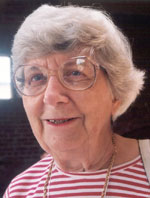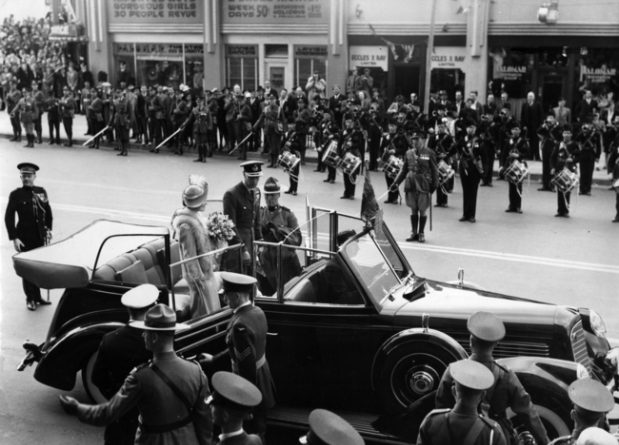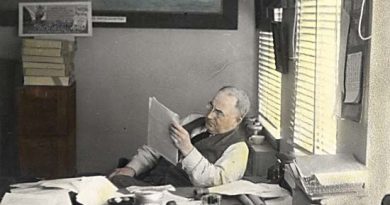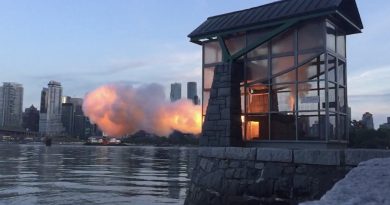Street Names
A Guest column by Derlang Ansager
“Imagine,” says the Vancouver Historical Society, “seeing King George VI and Queen Elizabeth being driven down Georgia Street in 1939 as thousands line the sidewalks and cheer . . . and all in colour!” That’s just one of the rare chunks of film you saw (free) at 7:30 p.m. on Thursday, February 22, 2009 at the Vancouver Museum. Colin Preston, the CBC’s Vancouver archivist, had a fine collection of film clips from the past, so this was one of the VHS’s more enjoyable events of the year.
Local television came to Vancouver in 1953 when the CBC opened their original studios at the corner of West Georgia and Bute, but the archives go back much further. There is a variety of footage of Vancouver and its residents, shot by professional film companies and amateurs alike. Some of it covers major events in the city, some consists of fascinating visual records of ordinary days in the 1930s, 1940s and 1950s.
Curiously, for an organization devoted entirely to history, the Vancouver Historical Society has no organized history of itself.

Author: Street Names of Vancouver
[Photo: BC Bookworld]
Thanks to the efforts of Elizabeth Walker, a longtime member of VHS, its archivist, and a past president, minutes of the earliest meetings of the Society—with some omissions—are preserved at the City of Vancouver Archives.
From those minutes we can construct a rough picture of the Society’s earliest days.
The Vancouver Historical Society began October 2, 1936 as the Vancouver Section of the British Columbia Historical Association. That explains why virtually all of its earliest public meetings dealt with subjects that had little or nothing to do with Vancouver history! The history of the Cariboo, mining in northern British Columbia, exploring the Kootenays . . . rarely did they venture into the lower mainland.
That 1936 organizational meeting was held in King Edward High School. The first president was Dr. W.N. Sage. It cost $2 to join in that seventh year of the Great Depression. A quarterly publication was already being issued by the BCHA. Its total circulation was 485, with 185 of those going to the members of the Vancouver Section.
A continuing problem in the earliest years of the Society was finding a place for its public meetings. The first were held in Harmony Hall at 1655 West Broadway. From there they moved to the Hastings Mill Store (in Pioneer Park at the north foot of Alma Street since 1930), then to Room 201 of the Hotel Vancouver.
On November 27, 1940 the Society found what would prove to be a regular home in the small dining room of the Grosvenor Hotel, which old-timers will recall was at 840 Howe Street, on the east side of Howe a little south of Georgia. The manager, Edgar Baynes, provided that space to the VHS free of charge. They were there for at least 20 years.
A digression: Edgar Baynes was a partner with Alfred Horie in the construction company that built the Grosvenor in 1913. A severe economic depression (although not quite as severe as the 1929 version) hit B.C. just as the hotel was completed, and the client couldn’t afford to keep it up. So the Baynes family took over the hotel, and operated it successfully for many decades.
Prominent names pop up all through those early years: Dr. Sage, of course, Judge F.W. Howay, Major J.S. Matthews, Dr. Margaret Ormsby, newspaperman Roy Brown, Capt. Charles Cates, Norman Hacking . . .
Exactly when the Vancouver Section of the BCHA became the Vancouver Historical Society is still a little vague: the transition happened during years in which the minutes are missing. Further research will pinpoint the date.
And a final note: the Society’s website, crafted by board member Bruce Watson and maintained by Quasar Design and Data Management is a rich treasure trove of local history.
p.s. Okay, one more final note: Colin will conclude his films presentation on the 22nd with a showing of the six-minute Harbeck film, the 1907 movie made on Vancouver’s busy streets a century ago.


![Crofton House ca. 1911 [Image: evelazarus.com]](https://vancouverhistory.ca/wp-content/uploads/2021/01/Alvo-Crofton-House-390x205.png)

